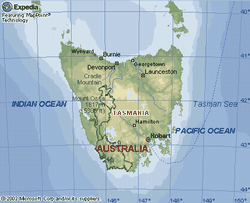Tue, Nov 02, 2010
First Multilateration System In Australia To Separate Aircraft
In Both En Route And Terminal Airspace
 The Wide Area Multilateration (WAM) system developed by Sensis
Corporation has passed its safety case by the Australian Civil
Aviation Safety Authority (CASA) and is now operational in airspace
covering Tasmania, Australia. The system uses both multilateration
and Automatic Dependent Surveillance - Broadcast (ADS-B) to provide
Airservices Australia with enhanced en route surveillance of air
traffic across the island and down to the surface at Hobart and
Launceston Airports. Sensis WAM's precise surveillance of aircraft
enables air traffic controllers to implement five nautical miles of
aircraft separation for safer, more efficient use of the airspace
in a region that was previously controlled with procedural
separation standards.
The Wide Area Multilateration (WAM) system developed by Sensis
Corporation has passed its safety case by the Australian Civil
Aviation Safety Authority (CASA) and is now operational in airspace
covering Tasmania, Australia. The system uses both multilateration
and Automatic Dependent Surveillance - Broadcast (ADS-B) to provide
Airservices Australia with enhanced en route surveillance of air
traffic across the island and down to the surface at Hobart and
Launceston Airports. Sensis WAM's precise surveillance of aircraft
enables air traffic controllers to implement five nautical miles of
aircraft separation for safer, more efficient use of the airspace
in a region that was previously controlled with procedural
separation standards.
"Sensis wide area multilateration was the most cost-effective
solution for surveillance over Tasmania today and also supports our
commitment to using ADS-B in the future," Airservices General
Manager, Technology and Asset Services, Alastair Hodgson said.
"This multimode approach is critical to ensuring safety and
airspace efficiency while ADS-B equipage grows."
Sensis WAM uses multiple low-maintenance, non-rotating sensors
to triangulate aircraft location based on transponder signals and
to provide air traffic controllers with precise aircraft position
and identification information, regardless of weather conditions.
With a higher update rate and greater positional accuracy than
traditional radar, Sensis WAM provides effective surveillance for
increased safety, capacity and efficiency of airspace and
airports.

The Sensis WAM system provides cooperative surveillance coverage
between Launceston and Hobart Airports, with accurate coverage of
150 meters or better from the ground level at the airports to
18,000 feet. Surveillance data is sent to the Melbourne Air Traffic
Control Center where it will provide controllers with information
to implement five nautical miles of separation in an environment
that had largely been controlled with procedural separation
measures.
"With Sensis WAM, Air Navigation Service Providers can deploy a
cost-effective, highly-accurate system that is compatible with
current and future surveillance technologies and is an ideal
complement to ADS-B," said John Jarrell, vice president and general
manager of Sensis Air Traffic Systems. "The technology is also
enabling ANSPs to significantly enhance the efficiency of airspace
by reducing separation standards."
Sensis is providing WAM solutions to leading ANSPs and
militaries around the world, addressing terminal and en route
surveillance, precision runway monitoring and special use airspace
applications.
More News
Airbus Racer Demonstrator Makes Inaugural Flight Airbus Helicopters' ambitious Racer demonstrator has achieved its inaugural flight as part of the Clean Sky 2 initiative, a corners>[...]
A little Bit Quieter, Said Testers, But in the End it's Still a DA40 Diamond Aircraft recently completed a little pilot project with Lufthansa Aviation Training, putting a pair of >[...]
Line Up And Wait (LUAW) Used by ATC to inform a pilot to taxi onto the departure runway to line up and wait. It is not authorization for takeoff. It is used when takeoff clearance >[...]
Contributing To The Accident Was The Pilot’s Use Of Methamphetamine... Analysis: The pilot departed on a local flight to perform low-altitude maneuvers in a nearby desert val>[...]
From 2015 (YouTube Version): Overcoming Obstacles To Achieve Their Dreams… At EAA AirVenture 2015, FedEx arrived with one of their Airbus freight-hauling aircraft and placed>[...]
 Airbus Racer Helicopter Demonstrator First Flight Part of Clean Sky 2 Initiative
Airbus Racer Helicopter Demonstrator First Flight Part of Clean Sky 2 Initiative Diamond's Electric DA40 Finds Fans at Dübendorf
Diamond's Electric DA40 Finds Fans at Dübendorf ANN's Daily Aero-Term (04.23.24): Line Up And Wait (LUAW)
ANN's Daily Aero-Term (04.23.24): Line Up And Wait (LUAW) NTSB Final Report: Extra Flugzeugbau GMBH EA300/L
NTSB Final Report: Extra Flugzeugbau GMBH EA300/L Classic Aero-TV: 'Never Give Up' - Advice From Two of FedEx's Female Captains
Classic Aero-TV: 'Never Give Up' - Advice From Two of FedEx's Female Captains



